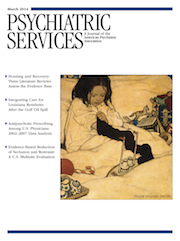Effects of Medicare Part D on Guideline-Concordant Pharmacotherapy for Bipolar I Disorder Among Dual Beneficiaries
Abstract
Objective
In January 2006 insurance coverage for medications shifted from Medicaid to Medicare Part D private drug plans for the six million individuals enrolled in both programs. Dual beneficiaries faced new formularies and utilization management policies. It is unclear whether Part D, compared with Medicaid, relaxed or tightened psychiatric medication management, which could affect receipt of recommended pharmacotherapy, and emergency department use related to treatment discontinuities. This study examined the impact of the transition from Medicaid to Part D on guideline-concordant pharmacotherapy for bipolar I disorder and emergency department use.
Methods
Using interrupted–time-series analysis and Medicaid and Medicare administrative data from 2004 to 2007, the authors analyzed the effect of the coverage transition on receipt of guideline-concordant antimanic medication, guideline-discordant antidepressant monotherapy, and emergency department visits for a nationally representative continuous cohort of 1,431 adults with diagnosed bipolar I disorder.
Results
Sixteen months after the transition to Part D, the proportion of the population with any recommended use of antimanic drugs was an estimated 3.1 percentage points higher than expected once analyses controlled for baseline trends. The monthly proportion of beneficiaries with seven or more days of antidepressant monotherapy was 2.1 percentage points lower than expected. The number of emergency department visits per month temporarily increased by 19% immediately posttransition.
Conclusions
Increased receipt of guideline-concordant pharmacotherapy for bipolar I disorder may reflect relatively less restrictive management of antimanic medications under Part D. The clinical significance of the change is unclear, given the small effect sizes. However, increased emergency department visits merit attention for the Medicaid beneficiaries who continue to transition to Part D.



